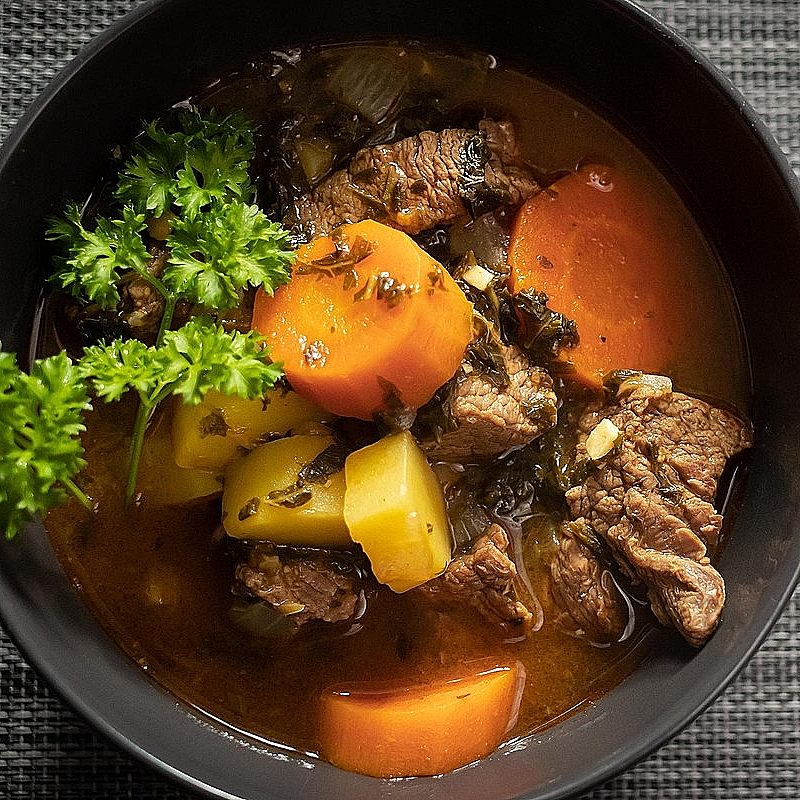Recipe for Cappu (Corsican Pot-au-Feu) - Ricetta di Cappu (Pòtu à furu corsu)
 Garanties sécurité
Garanties sécurité
(à modifier dans le module "Réassurance")
 Politique de livraison
Politique de livraison
(à modifier dans le module "Réassurance")
 Politique retours
Politique retours
(à modifier dans le module "Réassurance")
Recipe for Cappu (Corsican Pot-au-Feu) - Ricetta di Cappu (Pòtu à furu corsu)
"Corsican cuisine is a celebration of flavors."
Cappu, or Capu, is an iconic dish from traditional Corsican cuisine, known for its simplicity and richness of flavors. It is a rustic pot-au-feu made with sheep, lamb, or goat meat, slowly cooked in a fragrant broth. This dish is part of family meals, particularly during special occasions. It represents a long culinary tradition passed down through generations in handwritten recipe books, those precious collections of Corsican family recipes.
Here is the traditional recipe for Corsican Cappu, inspired by ancient Corsican cookbooks and historical texts.
Ingredients for 4 to 6 people:
- 1.5 kg of sheep or goat meat (bone-in pieces, such as shoulder, breast, or neck) - Carni di pecura o di capra
- 3 carrots, sliced - 3 carote tagliate a rondelle
- 2 onions, peeled and halved - 2 cipolle pelate e tagliate a metà
- 3 garlic cloves, crushed - 3 spicchi d'agliu schiacciati
- 2 celery stalks, chopped - 2 rametti di sedano tagliati a pezzi
- 2 potatoes, chopped - 2 patate tagliate a pezzi
- 1 bouquet garni (thyme, bay leaf, rosemary) - 1 mazzu di erbe aromatiche (timu, lauru, rosmarinu)
- Salt and pepper to taste - Sal e pepe à piacere
- Extra virgin olive oil - Oliu d'oliva extra-vergine
- Water (approximately 2 to 3 liters) - Acqua (circa 2 à 3 litri)
Preparation:
-
Prepare the meat:
- In a large pot, heat a little olive oil.
- Add the sheep or goat meat and brown it on all sides. This step is essential to develop the meat's flavors before slow cooking.
-
Add the vegetables:
- Once the meat is browned, add the onions, carrots, garlic, and celery to the pot.
- Sauté the vegetables lightly with the meat for a few minutes.
-
Slow cooking:
- Add water to the pot (about 2 to 3 liters, depending on the amount of meat and vegetables). The water should cover the ingredients.
- Add the bouquet garni and season with salt and pepper.
- Bring to a boil, then reduce the heat and let simmer slowly for 2 to 3 hours. This long cooking process allows the meat to become tender and release its flavors.
-
Add the potatoes:
- Halfway through the cooking, add the chopped potatoes. Let cook until the meat is tender and the vegetables are well-cooked.
-
Finalize the dish:
- Adjust the seasoning if necessary.
- Remove the meat and vegetables from the pot and arrange them on a serving dish.
- The sauce (or broth) can be served separately or used to drizzle over the meat and vegetables.
-
Serve:
- Cappu is typically served as a starter or main dish, often accompanied by Corsican cheese (such as brocciu or tomme corse) and fresh bread. It’s also delicious with a bit of Corsican red wine, like Patrimonio or Ajaccio.
Accompaniments:
- Chestnut flour bread from the countryside - Pane di farina di castagna di campagna: This type of bread is very popular in the mountainous regions of Corsica, where chestnut trees are abundant. Made with chestnut flour, water, and salt, it is often baked in traditional wood ovens.
- Corn bread - Pane di mais: Corn was cultivated in Corsica from the 17th century, and corn bread (or polenta) was commonly eaten by peasant families. This dense bread was often paired with vegetables or cheese.
- Sheep bread - Pane di pecura: In some rural areas of Corsica, bread was made from ancient grains like barley or rye, although wheat or chestnut flour bread was more common. This bread was often eaten with cheese, cured meats, or figatelli (Corsican sausage).
Traditional Corsican Beverages of the 18th Century:
-
Corsican wine:
- Wine was the main drink, especially red wines from grape varieties such as Niellucciu and Sciacarellu. White wine made from Vermentino was also popular. Sweet wines were used for festive or religious occasions.
-
Honey and water:
- Honey from the maquis was used to make a honey syrup diluted in water, a nourishing and medicinal drink. Honey, harvested by bees from thyme, lavender, and rosemary, was also consumed with warm milk.
-
Corsican Limoncello (or Limoncino):
- Traditionally made with Corsican lemons, limoncello is part of the local liqueurs produced from the island's fruits.
-
Vermouth:
- Corsica, with its trade links to Italy, produced local versions of vermouth, a flavored wine-based drink with herbs.
-
Brandy and local spirits:
- Grappa and chestnut brandy are examples of Corsican spirits distilled from local fruits, popular during this period.
-
Infusions and herbal teas:
- Herbal teas were common, often made from local plants such as thyme, verbena, or rosemary. These drinks were consumed for their digestive and soothing properties.
Historical and Cultural Notes:
- Cappu is an ancient recipe from Corsican rural traditions, where tougher cuts of meat were used, often sourced from local livestock. It was an ideal dish to feed many people during large gatherings.
- This dish is part of a "meat soup," where the meat slowly cooks to create a rich, flavorful broth.
- The 18th-century Corsican handwritten cookbooks are valuable testimonies of local culinary culture, often preserved in private archives or Corsican libraries.
Today, Cappu remains a deeply rooted traditional dish in Corsican culinary identity, widely prepared in homes across the island.


